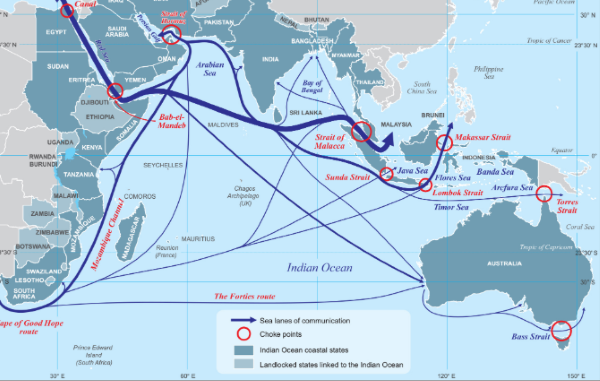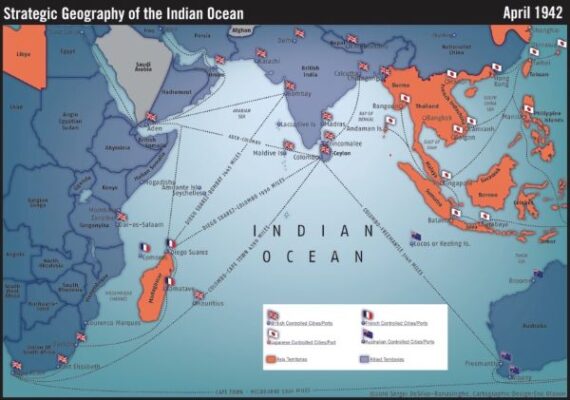Significance of the Indian Ocean Region for Australia
By Arundathie Abeysinghe
 At present, oceans play a significant role in trade as well as commerce. The Indian Ocean is the world’s third largest body of water with approximately 50% of trade traversing the Indian Ocean Region (IOR). Approximately, 50% of the world’s container traffic passes through the IOR, two thirds of the world’s maritime oil shipment, approximately one-third of bulk cargo transport and about 30% of world trade is also handled in the ports of this region. IOR comprises 38 littoral states, 24 ocean territories and 17 landlocked countries, including the hinterland and landlocked states of East Africa that utilize the Indian Ocean for trading and commercial purposes.
At present, oceans play a significant role in trade as well as commerce. The Indian Ocean is the world’s third largest body of water with approximately 50% of trade traversing the Indian Ocean Region (IOR). Approximately, 50% of the world’s container traffic passes through the IOR, two thirds of the world’s maritime oil shipment, approximately one-third of bulk cargo transport and about 30% of world trade is also handled in the ports of this region. IOR comprises 38 littoral states, 24 ocean territories and 17 landlocked countries, including the hinterland and landlocked states of East Africa that utilize the Indian Ocean for trading and commercial purposes.
The Indian Ocean is a vital conduit for global trade as well as it is home to many fast developing economies of the world. The Indian Ocean has strategic, political and economic significance for the whole world and it is a hub of natural resources with numerous significant minerals such as gold (about 80% of the world extraction of gold), manganese, nickel as well as marine food.
Regional security environment is a challenging issue due to strategic competition in the broader Indo-Pacific region as well as due to non-traditional threats; transnational crime, irregular maritime migration, piracy, terrorism, armed robbery at sea and illegal fishing, major issues that need to be addressed at present.

The economy of Australia depends on free as well as secure passage of maritime trade through the Indian Ocean. As the countries of the Indian Ocean rim are the neighbors, trade and security partners of Australia, it is necessary to maintain regional security and prosperity. Hence, it is crucial for Australia to have a secure, stable as well as interconnected Indian Ocean and Indo-Pacific region to maintain the country’s national security and prosperity. Therefore, Australia works in collaboration with regional partners in the Indian Ocean to overcome these issues.
Defense cooperation, strengthening regional organizations, playing a major role in international endeavors to address piracy, combat illegal fishing as well as drug trafficking are areas where Australia is working closely with its regional neighbors.
Meanwhile, according to the *United Nations Convention on the Law of the Sea (UNCLOS), Australia has jurisdiction over an Exclusive Economic Zone (EEZ) which extends up to a distance of 200 *nautical miles from the Australian coast. According to UNCLOS, Australia has sovereign rights to explore living and non-living natural resources of the waters and seabed as well as for other economic activity in its EEZ. This area includes waters surrounding Christmas Island (located 987 kilometers from *Northwest Cape, the closest point on the Australian mainland, 2,623 kilometers from Perth and 350 kilometers south of *Java Head) and Cocos (Keeling) Islands (located 2,768 kilometers north-west of Perth, 3,785 kilometers west of Darwin), the Indian Ocean territories of Australia that are strategically located in the Indian Ocean, a significant and strategic theatre.

These islands are strategically located on Australia’s north western maritime approaches; situated in close proximity to vital sea lanes which include Australia’s key export routes, Western Australia and North and East Asia. Hence, maritime security in the sea routes which pass in close proximity to Christmas Island and Cocos (Keeling) Islands is significant for Australia’s economy to combat maritime threat that originate from Southwest and Southeast Asia.
- Java – Bordered by the Indian Ocean to the south and *Java Sea on the north, Java is one of the islands of the Greater Sunda Islands in Indonesia and is considered as the world’s most populated island. Jakarta, the capital city of Indonesia is located on its northwestern coast.
- Java Head – This is a prominent cape at the extreme western end of Java located at the Indian Ocean entrance to the *Sunda Strait in Indonesia.
- Java Sea – This is an extensive shallow sea which is a part of the western Pacific Ocean.
- Northwest Cape – A peninsula located in the north-west of Australia.
- Nautical mile – One nautical mile is (internationally) defined as 1.852 kilometers.
- Sumatra- Located west of Java and south of the Malay Peninsula (a peninsula in Southeast Asia), Sumatra is a large island in Indonesia well-known for its wildlife, smoldering volcanoes and rugged rocky tropical terrain.
- Sunda Strait – This is a strait between the Indonesian islands of *Java and *Sumatra which connects *Java Sea to the Indian Ocean.
- United Nations Convention on the Law of the Sea (UNCLOS) – This is an International Convention which is also known as the Law of the Sea or Law of the Sea Treaty which was signed on December 10, 1982 in Montego Bay in Jamaica.
Image courtesy – navalinstitute.com.au & abhipedia.abhimanu.com







